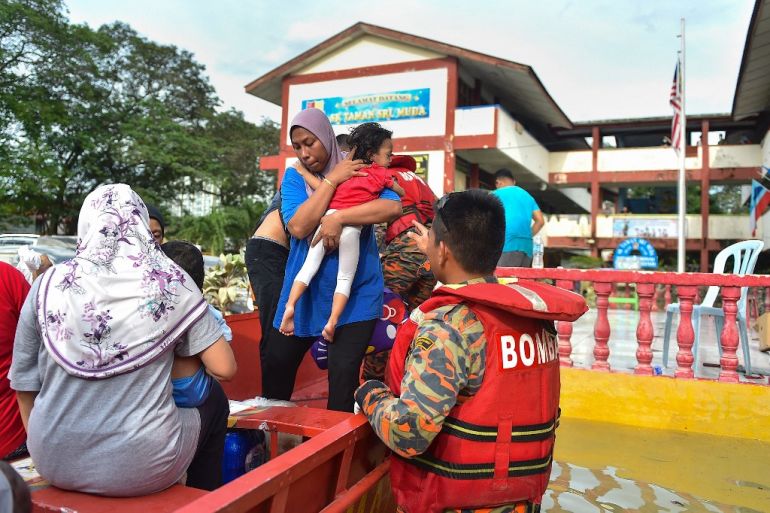Death toll from Malaysia’s worst floods in years rises to 27
Floodwaters have swamped cities, cut off roads and displaced an estimated 70,000 people in Malaysia.

The death toll from Malaysia’s worst floods in years has risen to 27, according to state media, as the weather bureau warned of continued thunderstorms and heavy rains in southern and eastern parts of the country.
The Bernama news agency said on Wednesday that 20 of the deaths were recorded in Selangor state, which encircles Malaysia’s capital, Kuala Lumpur.
Keep reading
list of 3 itemsColonial hill station becomes Malaysia’s third biosphere reserve
Floods in Malaysia displace more than 21,000 after heavy rains
Seven deaths were recorded in the eastern state of Pahang.
The floods, triggered by days of heavy rain over the weekend, have also displaced an estimated 70,000 people. With rivers overflowing their banks, cities have been swamped while major roads have been cut off.
According to Bernama, a total of 210 places in six states have been affected by the floods. Selangor – Malaysia’s most densely populated and wealthiest state – was one of the worst-hit areas.
Many in its flood-hit state capital, Shah Alam, said they were left stranded in their homes with barely any food for days, before being evacuated on boats in a chaotic rescue operation.
“We actually lost everything – our cars, our house. Everything gone,” said Chan Yung, who had been evacuated in Shah Alam.
“We hope the government will give us some support.”
Al Jazeera’s Florence Looi, reporting from Kuala Lumpur, said it is still too early to quantify exactly how much damage the flooding brought as many residents were still not able to return to their homes.
When the flooding was at its worst, the water level in some areas reached as high as five metres, according to Looi.
“The monsoon season is expected to last until February, so there’s potential for more rain and possibly more flooding to occur,” she added.
Met Malaysia, the weather bureau, said it expected more thunderstorms and heavy rain in the states of Selangor and Pahang on Wednesday.
Major roads swamped
The Malaysian government has mobilised thousands of emergency workers and military personnel to assist with search and rescue operations, but critics say it is not enough and volunteers have stepped in to provide food and boats for the rescue effort.
#Banjir : Hujan lebat pada awal pagi tadi menyebabkan laluan berhampiran Plaza Tol Bukit Jelutong dinaiki air.
Hati-hati ketika memandu dan pastikan anda sentiasa bersiap sedia dalam menghadapi sebarang kemungkinan.
Video : Orang Awam pic.twitter.com/iQdPioBVr2
— BERNAMA (@bernamadotcom) December 22, 2021
[A Twitter post shows flooding near a toll plaza west of Kuala Lumpur following heavy rain on Wednesday morning]
On Wednesday, the Malaysiakini news website reported that 31 people were arrested in the Taman Sri Muda district outside of Kuala Lumpur due to alleged looting, while an AFP journalist in one hard-hit Shah Alam neighbourhood reported seeing people desperate for food snatching items from a devastated supermarket.
Prime Minister Ismail Sabri Yaakob admitted on Tuesday there were “weaknesses” in the response to the disaster and pledged there would be improvements in the future.
“The responsibility is not that of the federal government alone, but also the state governments,” he added, noting a month’s rainfall had come down in a single day in Selangor.
Opposition legislator Fuziah Salleh described the official response as “hopeless” and “incompetent”.
“No early warning of the torrential rain was given,” she told AFP news agency. “It is so sad lives have been lost.”
Opposition politicians have accused the government of ignoring their calls to better prepare for the monsoon season, from November to February, particularly by improving drainage in densely populated urban areas.
The Southeast Asian nation is hit by floods annually during the monsoon season, but those at the weekend were the worst since 2014 when more than 100,000 people were forced from their homes.
Some 21 people were killed in 2014, while 10 were reported missing.
Global warming has been linked to worsening floods. Because a warmer atmosphere holds more water, climate change increases the risk and intensity of flooding from extreme rainfall.